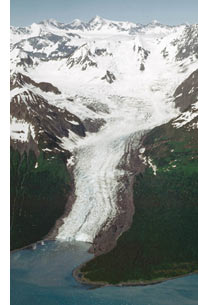Glacier and Landscape Change in Response to Changing Climate
 |
| August 8, 2000, west-looking oblique aerial photograph shows the calving, retreating terminus of Wellesley Glacier.. The debris-covered northern part of the terminus projects beyond the bare ice. Barren zones are visible along both sides of the glacier. High resolution image |
What is a GLACIER? - A glacier is a large, perennial accumulation of ice, snow, rock, sediment and water originating on land and moving down slope under the influence of its own weight and gravity. Glaciers are complex and dynamic and are continuously changing in response to changes in temperature, precipitation, and other geologic processes. Glacier ice crystals form slowly through the metamorphism of snow to "firn" to crystalline, bubbly ice. Glacier ice is a rock composed of one mineral, water. A temperate glacier is one in which during part or all of the year, liquid water coexists with ice. Hence, a small change in temperature can have a major impact on glacier melting, area, volume, and sea level.
For more information visit the USGS Web site Glaciers and Icecaps: Storehouses of Freshwater.
Where on Earth are glaciers located? - Glaciers exist on six continents: North America, South America, Asia, Europe, Africa, and Antarctica. They also exist on the north and south islands of New Zealand and on the island of Iryian Jaya. The largest glaciers cover almost all of Antarctica and Greenland. Greenland is considered to be part of North America. Australia has no glaciers. In the United States, glaciers exist in Alaska, California, Colorado, Idaho, Montana, Nevada, Oregon, Utah, Washington and Wyoming.
Using the analogy that 1,000 ice crystals represent all of the glacier ice on Earth, the global distribution of ice is:
For more information visit the USGS Web site Glaciers and icecaps: Storehouses of Freshwater.
Are there different kinds of glaciers?
Glaciologists recognize nine types of glaciers: continental ice sheets, ice caps, ice fields, outlet or piedmont glaciers, valley glaciers, mountain glaciers, glacierets, ice shelves, and rock glaciers. Glacierets, the smallest glaciers, can have an area as small as 1 hectare ( about 2.5 acres or100 meters by 100 meters). On the larger end, ice caps can be greater than 50,000 square kilometers (about 19,305 square miles) in area, while ice sheets are even larger. Ice caps and ice sheets completely cover the land surface. During the last ice age, the Pleistocene, large ice sheets covered much of North America.
For more information visit the USGS Web site Glossary of Glacier Terminology.
Glacier Home Page ||
Weather and Climate ||
Water on Earth ||
Introduction to Glaciers ||
Monitoring Earth's Glaciers ||
Glaciers and Sea Level ||
Glaciers of Alaska ||
Repeat Photography ||
Frozen in Time? ||
Additional Information